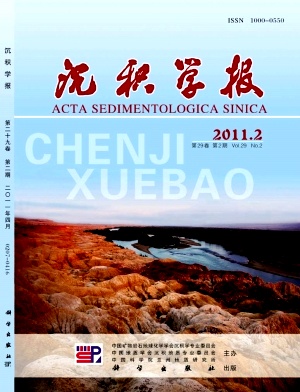Spatial Distribution Research on Contemporary Nontectonic Cracks in Mud Sediment at Yellow River Delta
- Received Date: 1900-01-01
- Rev Recd Date: 1900-01-01
- Publish Date: 2011-04-10
-
Key words:
- nontectonic cracks /
- mud sediment /
- Yellow River Delta /
- contemporary /
- quantitative
Abstract: This paper studied contemporary nontectonic cracks in mud sediment of delta plain at Yellow River Delta. Subaqueous shrinkage cracks, desiccation cracks and mixed origin cracks are studied in detail at the aspects of quantitative classification, fractal features, planar and sectional growth pattern and development models. This paper has established the quantitative characterization and comparison standards of different nontectonic cracks in modern mud sediment.
1. Description of crack types
Nontectonic cracks at Yellow River Delta can be divided into three types: Subaqueous shrinkage cracks, desiccation cracks and mixed origin cracks
Characteristics of subaqueous shrinkage cracks are: deep overlying water body; most with just one grade of cracks; smooth crack walls; large base crack unit area; cracks are more developed in sectors of shallow water than those in deep water in a long and narrow water body.
Characteristics of desiccation cracks are: usually multiple crack grades; Vshaped in vertical section; upward curling of crack unit margins due to desiccation.
Characteristics of mixed origin cracks are: the first type observed has secondary crack grades developed on the basis of previous subaqueous shrinkage crack due to subaerial exposure; the second type observed has two independent crack systems desiccation cracks overlying filled subaqueous shrinkage cracks.
The occurrence of many different crack types in this study area without significant microfacies changes can be attributed to the various volume and depth of overlying water body: for areas with deepest water and largest volume, subaqueous shrinkage cracks easily form because of more mud containing water; for areas with least water depth, only desiccation cracks develop; and for areas with water parameters between those of the first two, different kinds of mixed origin cracks develop highly possibly.
2. Statistical analyses of cracks
Quantitative classification of firstgrade crack unit area is applied to all study areas under the same criteria. The distribution of areas of subaqueous shrinkage cracks is the most centralized, which are mostly more than 500cm2; desiccation cracks unit areas have the largest area span; while the mixed origin cracks fall in between the first two, lacking areas of small figures.
Fractal dimensions are calculated for each crack area by the overlapping method. It is found that the fractal dimension rises from subaqueous shrinkage cracks to desiccation. Fractal theory can be well applied to analyze the planar density, complexity and connectivity of cracks, thus a good method in characterizing level of crack development.
3. Analyses of crack growth patterns
Similar planar growth patterns of all kinds of cracks are observed: New cracks develop at inflection points on the side of convex curvature. The intersection angle of new crack to host crack is greater than 70 , while the angle of bending crack to its original direction is less than 70 . A theory of shrinkage circle is adopted to demonstrate crack growth pattern. In vertical section, shrinkage sphere is used to illustrate the structure of bottomup subaqueous shrinkage cracks which are similar to the "flower structure" used to describe faults, whereas there is a distinct difference from the Vshaped topdown desiccation cracks.
4. Development models
Development models are established respectively for all types of cracks, in which relationships of mutual transformation of certain crack types are shown. Generally, from deep to shallow areas, subaqueous shrinkage cracks, mixed origin cracks and desiccation cracks develop in succession, and some of them can transform if affected by weather. It is possible that more types of mixed origin cracks appear under more complicated conditions.
5. Discussion
Although there seem to be numerous studies on spatial distribution of nontectonic mud shrinkage cracks, convincing theories of factors affecting crack development is still yet to be discovered. It is recommended more studies of crack simulation experiment on certain crack development factor(s) to be done in order to gain a better understanding of nontectonic shrinkage cracks.
| Citation: | CHENG Wei. Spatial Distribution Research on Contemporary Nontectonic Cracks in Mud Sediment at Yellow River Delta[J]. Acta Sedimentologica Sinica, 2011, 29(2): 363-373. |






 DownLoad:
DownLoad: